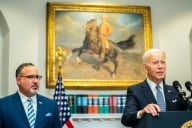You have /5 articles left.
Sign up for a free account or log in.
Lyn Wolfson knew something was awry when she received her invitation on Dec. 3 to teach spring classes at Columbia College Chicago.
Though she had been at Columbia since 1995, often teaching two or three courses each semester, her schedule of classes had been whittled down from three to one, without explanation, despite what she and colleagues described as positive-to-glowing evaluations.
Just as troubling, the number of students in her remaining class increased without any corresponding raise, she said. If current patterns continue for the remainder of the year, Wolfson's annual pay from the college will shrink from $28,000 to $9,000, she said.
When Wolfson brought her concerns to her union, the Part-time Faculty Association (which belongs to the Illinois Education Association, which is part of the National Education Association), she learned that as many as a dozen part-time faculty members in her department, arts, entertainment and media management, reported similar situations. An adjunct from the history, humanities and social science department estimates that 20 part-time faculty members, all of whom, like Wolfson, were at the top of the salary scale, lost courses this semester.
Campus-wide, as many as 100 adjunct faculty members, many of them with 15 to 20 years of service, have had their course loads reduced, often without notice, with sections either canceled or staffed instead by younger and less expensive teachers, according to the union. Columbia's administration contests the union's tally and says it has asked the union for data to back up its assertion but been rebuffed; the union worries that handing over its list would expose its members to potential retaliation. Inside Higher Ed has seen a partial list of affected part-time faculty members, with initials appearing instead of names, and counted 30 across three departments, in addition to the dozen faculty in arts, entertainment and media management already cited.
While tensions crop up regularly between adjuncts and administrators, or between adjuncts and full-time tenure-track faculty, the ramifications of the growing labor tensions could be especially far-reaching at Columbia. More than three-quarters of the 1,600-member faculty at the college work part time (and about the same proportion of those part timers are members of the union). The heavy reliance on part-time faculty has long been a point of pride at Columbia, a private, open-access college that takes a hands-on approach to teaching, particularly in the arts and media. Its public materials tout the fact that many members of its faculty are working professionals in their fields.
But part-time faculty members contend that a practice that began as a philosophical preference for exposing students to working professionals in their field has morphed, instead, into an economic one that leans on part-time and temporary instructors. What was once a good place to work, they say, has become untenable. "I truly think this is a profit thing," said Diana Vallera, president of the 900-member union. "It’s money, just money. That’s how people are being treated: you’re the replaceable worker."
“I’ve worked in many circumstances before, and this is the worst," said an instructor who has worked in the private sector as well as at Columbia, but whose contract at the college was not renewed this year (she asked that her name be withheld because she is appealing the matter and looking for work elsewhere). "Even in the corporate world I’ve never seen anything like what Columbia is going through right now.”
Louise Love, vice president for academic affairs at Columbia, said that nothing has changed substantively in the way classes have been scheduled at the college, though she acknowledged that an unspecified number of part-time faculty members were not assigned classes that they had taught previously.
The decisions were made on the basis of enrollment and other factors, she said, though it is unclear what the larger trajectory of enrollment has been. When asked for the past five years of data, Columbia offered statistics only from 2009 and 2010, when enrollment dropped by 204 students, or 1.7 percent. Full-time faculty get the first shot at teaching classes, with part timers assigned to the remaining classes based on qualifications or ability -- but not seniority, she said. "It’s something that is based strictly on student need and the needs of our curriculum," said Love.
Further compounding tensions is the fact that the union and administration are negotiating a new contract that elapsed at the end of August. The union also has filed three complaints with the National Labor Relations Board since January, alleging, among other things, that Columbia administrators have withheld information about which faculty members were assigned to what classes and how many have been replaced (which, again, was contested by the administration: "We have given information when we’ve been asked for it," said Love).
The union is also alleging to the NLRB that the administration's actions are tantamount to making substantive changes, on a unilateral basis, to their contract. "They’re not bargaining. They’re not sitting down trying to talk with the union or have discussions with us about working conditions," said Vallera. "We are at war."
War rhetoric does not sit well with administrators at Columbia, who see themselves as open to negotiations and characterize their relationship with faculty members as smooth. Love said the problems emanate from an overly combative minority, who also form the leadership of the union. "It’s really been in recent months that things have taken this turn," she said.
Love added in an e-mail to faculty that she was "disturbed" by war imagery and requested a return to civil discourse. "We urge all members of the college community -- full-time and part-time; faculty and staff -- to remember our shared commitment to our students and to act and speak in a collegial spirit with a united purpose," she wrote.
The union sees its stance as justified because, it says, the administration's actions represent an existential threat to teachers who have been there for decades. They say that stripping classes from longstanding and experienced faculty ultimately harms students. Wolfson said that her syllabus for oral communication is used as the template for the five sections of the course that are taught by other faculty, and that the section that she taught for years at the same date and time is now staffed by someone new to the course and department.
In addition, the notion that a collegial spirit once prevailed among Columbia's part-time faculty and administration is a myth, said John Stevenson, who has taught there for 20 years and had his three sections of philosophy reduced to two this semester, after one was canceled. The union came into being in 1998 over the objections of the administration at that time, which has since turned over. When it was launched, the union's chief goal was to achieve what once seemed unthinkable -- getting paid $3,000 per course. The salary scale now ranges from $3,756 per class, after a member joins the union in his or her second semester of teaching, to $4,770 at the top of the scale.
But Stevenson acknowledged that part of Love's critique is correct. Following a November election that brought in a new slate of leaders (including Stevenson as treasurer), the union has become more assertive. But he said it is by necessity, not choice.
"We do have a union leadership that wants to, is willing to, and sees the necessity of opposing the harsh kinds of moves the administration has been making over the past year," he said before pronouncing his judgment. “Columbia would rather not have a union. They’d rather have the college do as it wants without any sort of hindrance.”








